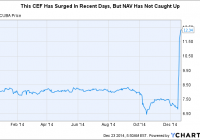Diving Into The Herzfeld Caribbean Basin Fund
Summary CUBA is a closed-end fund focusing investment in the Caribbean. CUBA is currently trading at a 20% premium to its NAV. News in Caribbean has been large driver of fund since it’s inception, that could be changing. A few months ago I wrote an article attempting to recommend ways to profit from the newly rekindled U.S. and Cuban relationship. In this article, I recommend, among other options, the Herzfeld Caribbean Basin Fund (NASDAQ: CUBA ). After receiving a few messages and comments speaking on the haziness of this fund and the caution that should be exercised with it, I was prompted to further research and analyze the fund. In this article, I will divulge my unbiased findings on the fund. Overview CUBA is a closed-end fund that focuses on investment in companies that have potential to recognize large revenue increase from the economic development of Caribbean countries, including, but not limited to, Cuba, Dominican Republic, Costa Rica, and many others. By using a long-term investment strategy, the fund attempts to position itself in such a way to profit from not only tourism in the Caribbean, but also from projects and investments to improve infrastructure, trade, and the standard of living in the region. As the fund’s homepage states, the ultimate goal and investment strategy is long-term capital appreciation, driving fund manager, Thomas J. Herzfeld, to make investments in companies that are not only risk averse, but also poised to grow alongside the region. Findings The elephant in the room with this fund, and the most obvious concern from the comments on my aforementioned article received, is the fund trading at around a 20% premium to its net asset value. This is a red flag for investors, and has been a concern for the past 9 months. Investors do not want to pay a price 20% higher than the value of the assets, before fees, for a fund with a seemingly risky premise. Trading at a premium is a relatively young trend in the larger picture, starting in late 2014 after almost 5 years of discounted trading in relation to its NAV. It is important to analyze the factors that may be causing the sudden jump in price of this closed-end fund. The predominant explanation is investor excitement around Cuba. The trend towards Cuban relations is an unpredictable and exciting one, and investing in something so unknown can be a daunting decision for even experienced investors. This makes a fund that has been involved in the Caribbean for many years an attractive option. The continued news about Cuba has sparked the interest of many investors and the Herzfeld Caribbean Basin Fund is riding a wave of excitement that could very well be the largest contributing factor to the premium it is currently trading at. This is what fund founder and manager Thomas Herzfeld had to say about the topic in an interview with Barron’s. “Yes, it hit $15 a share, and the net asset value was about $7 or $8. That’s in keeping with its history. Whenever there is good news on Cuba, it reacts like that.” The last transition from a discount to a premium price point that the fund made was in late 2014, putting it right on track with the date that movement toward restored diplomatic relations between Cuba and the U.S. was making news, confirming Mr. Herzfeld’s statement. The correct question to ask now is, is this price and growth sustainable? As it is evident that the price of the fund largely depends on Cuba, it would appear that after news dies down the fund will fade with it. On the contrary, if the news gives way to palpable improvement in the market, especially in Cuba, the fund is poised to profit from growth in that nation and all across the Caribbean. The fund has existed solely in a time period when good or bad news was the most influential driver of price. The realization of actual action and efforts to improve relations with Cuba have put a new era of tangible growth from real economic improvement into the realm of possibility for the Herzfeld Caribbean Basin Fund. If this is the case, then it is only a matter of time before the NAV catches up with price as companies reap profits and success while the Caribbean becomes an emerging market and hub for economic and infrastructural development. In addition to the inflated price, investors also pay the management fees for investing in a fund, adding an additional expense to cut into final profits. In the financial reports from the fund, it can be seen that virtually all investments, 99.36%, are common stocks. The fund has no direct investment in the Caribbean, but that being said, the diversity in its portfolio is worth mentioning. The largest portion of the portfolio, 16.75% belongs to leisure stocks, including cruise lines such as Carnival Corp (NYSE: CCL ) and Royal Cruise Lines (NYSE: RCL ), both poised to reap profits from growth in the Caribbean, especially Cuba. The next largest segment belongs to airlines at 15.17%, with investment in airline companies that serve the Caribbean and stand to profit from prosperity in the region. Another important and potentially profitable fund investment focus is in infrastructure. Herzfeld and his team have portioned 11.64% of holdings to construction and materials companies including MasTec (NYSE: MTZ ) and Vulcan Materials (NYSE: VMC ), both companies are based in the southern United States and both are standing ready to supply Cuba with the infrastructure it needs to grow as a country. This could lead to the recognition of profits for the fund and the advancement of the Cuban economy. Investment in these companies not only finds profit from their role in bolstering Cuban infrastructure and economy, but also shows promise in helping other holdings that will feed off of an improved Cuba. Fees to own CUBA are 3.64%, which begs the question, is it worth paying a premium to the NAV and fees for a portfolio of mostly common stocks, of which I could simply own myself? The simple answer, by investing in this fund, one is investing in not only the sum of its holdings, but convenience of immediate diversification and exposure to an exciting market, paired with the expertise of management that has knows the region and has been in business there for years. Manager of CUBA, Thomas J. Herzfeld is a closed-end fund and Caribbean veteran, having written a number of articles and books on the topic, paired with living in Miami for 40 plus years, it was hard for him to not become a Caribbean expert, primarily Cuban. This expertise in both has only been sharpened since he started the Herzfeld Caribbean Basin Fund in 1993. Conclusion The primary concern when analyzing this fund is its relative volatility compared to its price. When the fund trades at a premium to its NAV, it is due mainly to outside factors influencing investor excitement about an intriguing market. It is advisable to proceed with discretion with any investment, but given the volatile nature of CUBA, one should truly analyze the cause and effect nature of the Caribbean and Cuban market exists in and the subsequent cause and effect nature of this market on share prices of not just the fund as a whole, but the companies it holds. It is well within the realm of possibility to see steady and reliable growth in the Caribbean and ensuing growth and performance from CUBA. That said, we could be staring down another situation of investor excitement sending share prices and hopes into the stratosphere only to come crashing down when the reality of the situation does not live up to the high expectations set for it. Disclosure: I/we have no positions in any stocks mentioned, and no plans to initiate any positions within the next 72 hours. (More…) I wrote this article myself, and it expresses my own opinions. I am not receiving compensation for it (other than from Seeking Alpha). I have no business relationship with any company whose stock is mentioned in this article.

